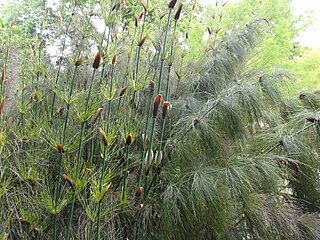
The Restionaceae, also called restiads and restios, are a family of flowering plants native to the Southern Hemisphere; they vary from a few centimeters to 3 meters in height. Following the APG IV (2016): the family now includes the former families Anarthriaceae, Centrolepidaceae and Lyginiaceae, and as such includes 51 genera with 572 known species. Based on evidence from fossil pollens, the Restionaceae likely originated more than 65 million years ago during the Late Cretaceous period, when the southern continents were still part of Gondwana.

Disa is a genus of flowering plants in the family Orchidaceae. It comprises about 182 species. Most of the species are indigenous to tropical and southern Africa, with a few more in the Arabian Peninsula, Madagascar, and Réunion. Disa bracteata is naturalised in Western Australia, where the local name is "African weed-orchid."
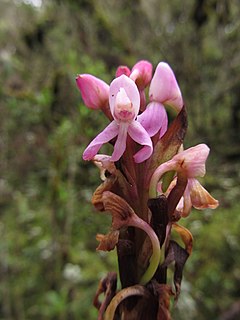
Disa stairsii is a species of Disa of the family Orchidaceae that can be found growing with the giant heathers on the Rwenzori Mountains of mountains in East Tropical Africa as well as in the Congo in West-Central Tropical Africa.

Disa bracteata, also known as South African weed orchid is a species of orchid native to South Africa.

Disa cardinalis is a species of orchid found in South Africa.

Disa cernua is a species of orchid found in South Africa, in Eastern Cape and Western Cape provinces.

Disa cornuta is a species of orchid found from Zimbabwe to South Africa.

Disa draconis is a species of orchid found in South Africa.
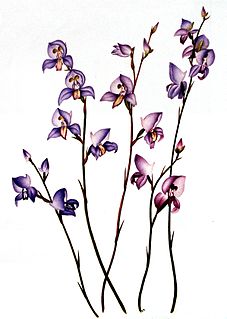
Disa purpurascens is a species of orchid found in South Africa. It is also known as the early blue disa or the bloumoederkappie.
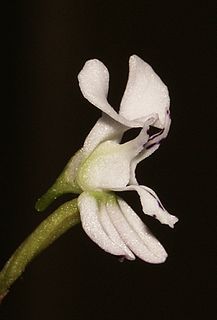
Disa sagittalis is a species of orchid found in South Africa from south and southeast Cape Province to southern KwaZulu-Natal.

Disa tripetaloides is a species of orchid that grows along the edges of streams in South Africa. This is one of the smaller species in the genus Disa in the section Disa. There are populations that come from the winter-rainfall areas of South Africa, and summer-rainfall areas of South Africa.

Pachites is a genus of flowering plants in the orchid family, Orchidaceae. It contains two known species, both endemic to South Africa. One of these, Pachites appressus, is very rare.

Diseae is an orchid tribe in the subfamily Orchidoideae. It was recognized in Genera Orchidacearum volume 2, which was published in 2001. It consisted of 12 genera in five subtribes. In molecular phylogenetic studies that were published after 1999, it was shown that Diseae is paraphyletic over the tribe Orchideae. In a classification of orchids that was published in 2015, Diseae was not recognized, but was instead placed in synonymy under Orchideae.
Disa borbonica is a species of orchid in the Orchidaceae family. It is endemic to Réunion.
Ceratocaryum is a group of plants in the Restionaceae described as a genus in 1836. The entire genus is endemic to Cape Province in South Africa.

Disa graminifolia is a species of orchid found in the Cape Floristic Region of South Africa.

Disa ferruginea is a stout, reed-like terrestrial 200–450 mm tall. Radical leaves linear, developing after flowering; cauline leaves dry, sheathing. Inflorescence dense, 1–40 flowered. Flowers bright red to orange, often with some parts yellow. Median sepal apiculate, galea 8–10 mm deep; spur slender, grading into the galea, 7–20 mm long; lateral sepals projecting away;elliptic to narrowly elliptic, with apiculi up to 4 mm long;petals spear-shaped, 5–7 mm long; lip narrowly egg- to spear-shaped, 10–12 mm long.
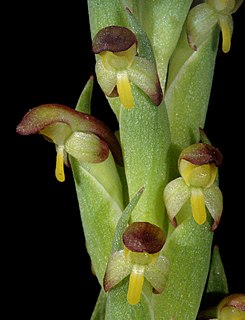
Disinae is a subtribe of orchids that has been differently defined and placed in the two classification systems that are currently in use for orchids. Genera Orchidacearum, which is currently the definitive work on orchid taxonomy, delimits Disinae as consisting of two closely related genera, Disa and Schizodium, and it places Disinae in the mostly African tribe Diseae, along with four other subtribes: Brownleeinae, Huttonaeinae, Coryciinae, and Satyriinae. In the classification for orchids that was published by Chase et alii in 2015, Schizodium was placed in synonymy under Disa, while Pachites and Huttonaea were transferred to Disinae. In Genera Orchidacearum, Pachites and Satyrium form the subtribe Satyriinae, and Huttonaea is the sole genus in the subtribe Huttonaeinae. The transfer of Pachites and Huttonaea to Disinae by Chase et alii (2015) was done with considerable doubt, and was based upon uncertainty about the relationships of these two genera. In 2009, a molecular phylogenetic study found only weak statistical support for a sister relationship between Huttonaea and Disa.
Disa intermedia is a species of orchid, native to Eswatini, formally Swaziland.














